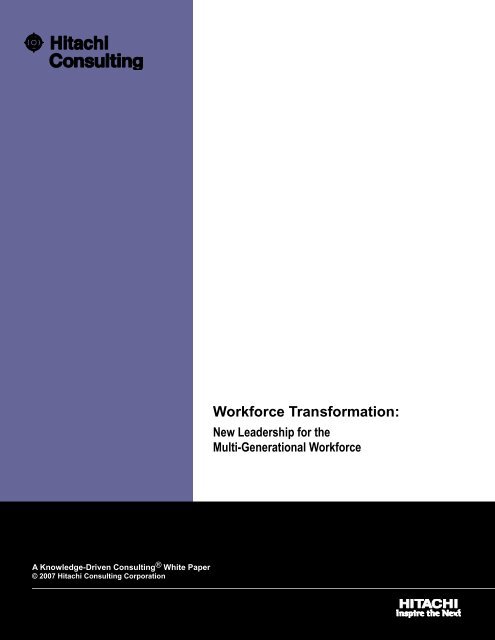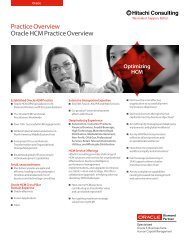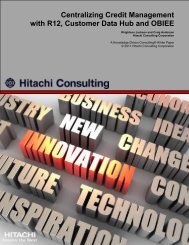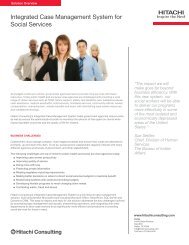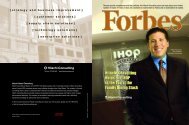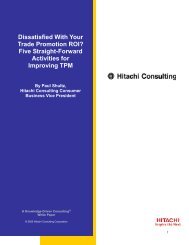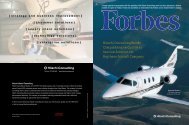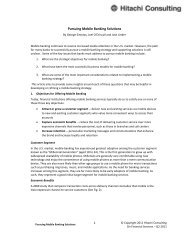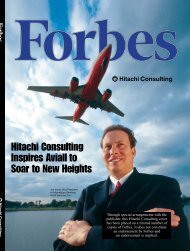Workforce Transformation: - Hitachi Consulting
Workforce Transformation: - Hitachi Consulting
Workforce Transformation: - Hitachi Consulting
You also want an ePaper? Increase the reach of your titles
YUMPU automatically turns print PDFs into web optimized ePapers that Google loves.
A Knowledge-Driven <strong>Consulting</strong> ® White Paper<br />
© 2007 <strong>Hitachi</strong> <strong>Consulting</strong> Corporation<br />
<strong>Workforce</strong> <strong>Transformation</strong>:<br />
New Leadership for the<br />
Multi-Generational <strong>Workforce</strong><br />
1
Contents<br />
Does Leadership Need to Change? ............................................................. 3<br />
The Coming Leadership Crisis ..................................................................... 3<br />
A Theory of Generations ............................................................................... 4<br />
Defining the Generations .............................................................................. 5<br />
The Generations at Work .............................................................................. 6<br />
The Solution to Leading the Multi-Generational <strong>Workforce</strong>:<br />
Knowledge Capital Management .................................................................. 10<br />
Conclusion ..................................................................................................... 12<br />
About the Author ........................................................................................... 12<br />
About <strong>Hitachi</strong> <strong>Consulting</strong> .............................................................................. 13<br />
References ..................................................................................................... 15<br />
2
―Within a decade, the massive<br />
boomer generation will begin to<br />
retire. At the same time,<br />
declining birth rates will mean<br />
fewer younger workers. Through<br />
savvy use of flexible work<br />
arrangements, innovative<br />
learning opportunities, and<br />
creative compensation and<br />
benefits programs, companies<br />
have the opportunity to retain<br />
valuable employees and prevent<br />
a "brain drain."<br />
— Ken Dychtwald<br />
President of Age Wave<br />
“Almost 8,000 Boomers turn 60<br />
every day.‖<br />
— U. S. Census Bureau<br />
Does Leadership Need to Change?<br />
Roger was a management consultant. For 20-plus years he helping clients build<br />
better relationships with their customers. Roger found that while segmenting<br />
customers, age was almost always a primary or secondary predictor of customer<br />
preferences and behavior. No surprise that data clearly indicated age matters,<br />
but why did it matter, he wondered? Were people changing their likes and<br />
dislikes as they became older? Were they adopting new behaviors as they<br />
passed through different life stages such as school, marriage, parenthood, or<br />
retirement? Roger sensed this was only part of the story. There were also<br />
differences that formed in certain age groups and persisted as that group grew<br />
older. He would find to his suprise this was also true of his workforce.<br />
Roger often interviewed bright, motivated, young people coming out of<br />
school and seeking a career in consulting. One particular interview,<br />
however, started a bit differently. When he went into the lobby to greet a<br />
candidate, she was sitting with another woman, having a conversation. As<br />
he walked back to his office with the candidate, he asked how she knew<br />
the other woman.<br />
"Oh, she's my mother,” she said. “She just wanted to check out what kind<br />
of place I might be working for.”<br />
This left Roger scratching his head. He couldn’t understand why a young<br />
person would bring a parent to a job interview or why a parent would<br />
agree to go. He also wasn’t sure why it bothered him so much.<br />
Had he known then what he knows now about the unique perspective of<br />
each of the three generations involved that day (Millennial job candidate,<br />
Gen-X manager, and Boomer parent), it would have been crystal clear.<br />
Roger vowed to learn more about what this new generation of workers<br />
valued and how to get the best performance from them. He found a<br />
delightful divergence of generations and an alarming convergence of<br />
trends pointing to a coming crisis in leadership.<br />
The Coming Leadership Crisis<br />
A historic generational shift that will lead to a crisis in American business<br />
leadership is underway. Companies that understand this shift and take action will<br />
retain their senior leaders, attract the next level of top talent, and cultivate a new<br />
generation of leaders. Those that don’t will find it increasingly difficult to compete<br />
in a complex, rapidly changing, global marketplace.<br />
The American workforce is changing in ways that are certain to create a<br />
shortage of experienced leaders at the precise time that large enterprises are<br />
becoming increasingly difficult to manage. These changes are due to basic<br />
demographics, structural changes in organizations, and generational attitudes<br />
and behaviors. The same demographics that warn of a future fiscal crisis in<br />
Social Security and Medicare will first fuel a leadership crisis in American<br />
business. Simply put, demographic trends have predestined that large numbers<br />
of workers are now reaching retirement age with fewer workers to replace them.<br />
3
―10 million positions will go<br />
unfilled in the U.S. by 2012.‖<br />
— Bureau of Labor Statistics<br />
―The United States is on the<br />
brink of a generational<br />
transition the likes of which<br />
has not been seen before. The<br />
largest generation in history to<br />
retire—some 77.5 million<br />
people, according to the<br />
AARP—will begin vacating the<br />
workplace in the next five<br />
years. And over the next 15<br />
years, our workplaces will<br />
continue to shift to a new<br />
generation of leaders.‖<br />
—Deborah Gilburg<br />
CIO Magazine<br />
It is estimated that almost 8,000 Boomers turn 60 every day. The peak year of<br />
the Boomer generation was 1957 with 4.33 million births, compared to a Gen-X<br />
generation low of 3.14 million in 1975. Those aged 45-55 (born 1952-1962) are a<br />
healthy 46 million, but that number drops to 37 million aged 30-40 (born 1967-<br />
1977). Immigration has filled part of this gap. In fact, Gen-X immigrants number<br />
over 17 million, according to the U.S. Census, but immigration will not avert the<br />
leadership crisis where as many as 10 million positions will go unfilled in the U.S.<br />
by 2012, according to the Bureau of Labor Statistics.<br />
Failing to understand the impact of these demographic forces, companies have<br />
followed short-sighted, cost-cutting strategies that have downsized, outsourced,<br />
or made contingent millions of skilled and capable employees. Some of these<br />
strategies were aimed directly at senior and mid-level management through buyouts<br />
and early retirement programs contributing to the thinning ranks of<br />
experienced leadership. There is a contradiction here. On the one hand,<br />
companies are waging a “War for Talent,” while on the other hand, experienced<br />
managers in their 50s and 60s remain unemployed and underemployed. Age<br />
discrimination and outdated recruiting and hiring practices have certainly<br />
contributed to this situation.<br />
Specific characteristics of each generation are contributing to the crisis as well.<br />
Many Boomers in their 50s and 60s are leaving the corporate world in search of<br />
more meaningful, spiritually fulfilling work. Others are hoping to downshift into a<br />
more flexible work arrangement. Gen-Xers in their 30s and 40s practically<br />
invented the job-hopping, free-agent career path that came to dominate the<br />
1980s and 1990s. In addition, Gen-Xers’ strong risk-taking, entrepreneurial bent<br />
makes them a challenging cohort to lock into long-term employment. This means<br />
that in many companies there are few mid-level leaders who possess the<br />
sustained institutional knowledge of a company’s products, customers,<br />
and operations.<br />
Now in their teens and 20s, many Millennials are most comfortable in a<br />
structured environment that provides supportive coaching and mentoring. This<br />
implies that in the future, companies may require more—not less—mid-level and<br />
senior management. In many ways, the old command and control leadership that<br />
worked well for the G.I. Generation, those born between 1901 and 1924, is well<br />
suited to the needs of the next “Greatest Generation,” the Millennials.<br />
The impact of this leadership crisis will leave many companies without the<br />
senior, mid-level, and emergent management talent required to effectively<br />
compete. Companies that take steps now to address the crisis will be positioned<br />
to thrive. In this whitepaper, we’ll delve into those steps, but before we get to that<br />
it is important to understand the basic mechanisms of generational theory and<br />
learn a bit about who the generations are.<br />
A Theory of Generations<br />
Everyone is familiar with the idea of generations. Popular media labels such as<br />
the “Me Generation” or the “generation gap” have been with us for decades.<br />
Politicians attack budget deficits based on the impact on “future generations” or<br />
support entitlement programs that benefit the “older generation.” But, as we will<br />
see, there is a great deal of confusion about who the generations are, how they<br />
are differentiated, and why they are important.<br />
A modern theory of generations is typically credited as originating with German<br />
sociologist Karl Mannheim (1893-1947) and his essay, “The Problem of<br />
Generations.” Dr. Mannheim described how a cohort’s “fresh contact” with the<br />
prevailing culture led to differentiation between generations. A rising generation<br />
with different formative experiences stands in opposition to the prevailing culture,<br />
the proverbial “generation gap.” He also explained that youth are primary<br />
participants in war, revolution, immigration, urbanization, technology, and other<br />
social upheavals. Uncommitted to a career, family, or way of life, and impacted<br />
by these transformational events, each particular generational cohort is a<br />
powerful force for pressing alternatives to the status quo.<br />
4
Defining the Generations<br />
Generation Birth Years Notable Members<br />
There is often confusion in the definition and use of the term “generation.” The<br />
origin of the word generation is from the Greek word genesis, and traditionally<br />
stood for a parent-child relationship. A second definition of generation is an agerelated<br />
group or cohort with a collective identity. The first definition implies the<br />
transmission of stable cultural norms and values from one generation to the next;<br />
while the second definition emphasizes the profound differences between<br />
generations caused by a rapidly changing modern society. It is this second<br />
definition that we are interested in here.<br />
There is also a great deal of confusion about which and how many years define<br />
a generation. Marketers and researchers have employed a wide range—from<br />
seven years to 30 years—as delineating a generation. For example, the Boomer<br />
Generation is popularly defined by 19 years (1946-1964), whereas Generation X<br />
is sometimes defined by a much shorter 13-year period (1965-1977). Defining<br />
the year a generation starts is also problematic. For example, in some definitions<br />
the Boomer Generation begins as early as 1940 and in other definitions, as late<br />
as 1947. This is important because the length and start date of a generation can<br />
have a dramatic effect on the size and composition of that generation.<br />
The most useful standard is the one proposed by William Strauss and Neil Howe<br />
in their 1991 book, Generations, which is based on the historical analysis of the<br />
common characteristics of each generation. Some of the notable members of the<br />
various generations and their birth years, using the Strauss and Howe standard,<br />
are included in Table 1.<br />
G.I. 1901-1924 John Kennedy, Glenn Miller, Ernest Hemingway, Joe Louis<br />
Silent 1925-1942 Dr. Martin Luther King, Colin Powell, Jack Kerouac, Gloria Steinem<br />
Boomer 1943-1960 Bill Clinton, Elvis Presley, Steven Spielberg, Oprah Winfrey, Bill Gates<br />
Gen-X 1961-1981 Michael Dell, Barack Obama, Jodie Foster, Kurt Cobain, Tiger Woods<br />
Millennial 1982-2003 Sasha Cohen, Scarlett Johanssen, Frankie Muniz, Shawn White, Lebron James<br />
Table 1. Strauss and Howe’s Generational Labels and Intervals: United States 1901-2006<br />
Generations are becoming an increasingly important social concept. One<br />
important factor is the decline of race, gender, and class as cultural battle lines.<br />
Progress on creating a multi-cultural society has reduced racial differences, and<br />
women’s economic empowerment has placed them on a more equal footing with<br />
men. Additionally, the triumph of capitalism over communism on the world stage<br />
has reduced the emphasis on class divisions.<br />
Another factor is that the pace of change in our society has quickened,<br />
enhancing and emphasizing the differences between age groups. Consumer<br />
culture, with its rapidly changing styles and trends, gives each generation the<br />
clothes, music, books, and heroes to express their values and way of life. In<br />
addition, as advances in health and medicine make it possible for the majority of<br />
Americans to live longer and remain vital into their 70s and 80s, more<br />
generations are active at any one time. This also engenders the potential for<br />
intergenerational conflict, particularly in the area of government entitlement<br />
programs. Finally, the impact of the large activist, post-war Boomer cohort in<br />
raising the consciousness of generational issues cannot be understated.<br />
5
―For Generations X and Y, the<br />
old command and control<br />
leadership is passé. The top<br />
down leadership style that<br />
grew from a military model is<br />
not effective in today’s world<br />
of rapid change. Today’s<br />
young leaders act first and<br />
evaluate later, because a<br />
leader cannot afford to<br />
carefully evaluate first in the<br />
high-speed environment of<br />
today."<br />
— W. Bennis & R. Thomas<br />
Geeks & Geezers:<br />
How Era, Values and<br />
Defining Moments<br />
Shape Leaders<br />
The Generations at Work<br />
There are currently four active generations in the workforce: Silent, Boomer,<br />
Gen-X, and Millennial. In order to counter the coming crisis, company leaders<br />
must understand the formative influences on each generation, what they value at<br />
work, and how to get the best performance from them. By maximizing the<br />
leadership potential in each of these active generations, companies will provide<br />
a leadership advantage over their competitors. In the final section of this<br />
whitepaper, we address three disciplines that will enable companies to make this<br />
advantage a sustainable one. But first, let’s meet the generations at work.<br />
The Silent Generation<br />
The Silent Generation is made up of those people born between 1925 and 1942.<br />
This cohort was mostly too young to fight in WWII and came of age in the late<br />
1940s and 1950s. Many married early and worked for large corporations under<br />
the command and control of their G.I. Generation elders. This generation is often<br />
associated with its many introspective intellectuals and thoughtful social activists,<br />
such as Sandra Day O’Connor, Dr. Martin Luther King, Jr., and Gloria Steinem.<br />
Later in life the Silent Generation broke away from conformity in a “mid-life<br />
crisis,” resulting in soaring divorce rates and other social ills.<br />
Primarily in their 60s and 70s, this generation is the smallest generational group<br />
in the workforce and is leaving the workforce at a rapid rate. They are the<br />
technicians and engineers of atomic energy, jet aircraft, and moon rockets. Silent<br />
Generation workers swear by standard operating procedures and loyalty to one<br />
company. They are motivated by the satisfaction of a job well done. Their<br />
communication style is more formal with face-to-face and phone communication<br />
instead of e-mail or voice mail. They are motivated by recognition such as<br />
awards and plaques. Silent Generation workers are now the primary<br />
beneficiaries of social entitlement programs such as Social Security and<br />
Medicare. In retirement, Silent Generation workers are also collecting significant<br />
pensions and health benefits. However these types of programs have been put<br />
at risk because Silent Generation-era industries, such as automotive, chemicals,<br />
materials, and manufacturing have undergone a profound realignment.<br />
The strategic imperative is for companies to preserve the experience,<br />
knowledge, and wisdom of the Silent Generation. In industries such as<br />
aerospace and defense, Silent Generation managers hold much of the tacit<br />
knowledge associated with company products that have long service lives. By<br />
focusing on knowledge management and transfer, a topic discussed in the final<br />
section of this whitepaper, leaders can mitigate the loss of this knowledge.<br />
Additionally, by developing an active alumni network, companies can tap into this<br />
knowledge even after Silent Generation workers have retired.<br />
The Boomer Generation<br />
The much analyzed Boomer Generation represents those people born between<br />
1943 and 1960. This cohort began life in an idyllic Father Knows Best conformity<br />
in the 1950s and came of age in the 1960s rebelling against the world that their<br />
G.I. and early Silent Generation parents had built for them. The Vietnam War<br />
and campus protests against it galvanized the collective identity of this cohort.<br />
This generation is often associated with an outspoken idealism and a somewhat<br />
self-absorbed “Me Generation” attitude. After disillusionment set in during the<br />
1970s, this generation became Yuppies, New Agers, Evangelicals, and Cultural<br />
Warriors. In presidential politics, the baton was passed directly from George<br />
Bush, Sr. (G.I.) to William Jefferson Clinton (Boomer), thus bypassing a whole<br />
generation of accomplished Silent Generation politicians.<br />
6
―Between 1993 and 2003, a<br />
profound revolution has taken<br />
place in the values and norms<br />
of the American workplace.<br />
In this change – called the<br />
Generational Shift – the<br />
prime-age workforce will be<br />
made up increasingly of<br />
Generation X and Generation<br />
Y (born 1978-1986). As<br />
Generation X and Generation<br />
Y come to dominate the<br />
prime-age workforce, they will<br />
usher out the last vestiges of<br />
the old-fashioned workplace<br />
values and norms and finish<br />
the workplace revolution.‖<br />
— Bruce Tulgan<br />
Key Findings of A Ten Year<br />
Workplace Study<br />
RainmakerThinking, Inc.<br />
Primarily in their late 40s through early 60s, this generation is the largest<br />
generational group in the workforce. Boomers are competitive, value expertise,<br />
and believe in paying their dues. However, Boomers also retain a 1960s-era<br />
idealism and daydream about leaving the corporate world in search of more<br />
meaningful, spiritually fulfilling work, as mentioned above.<br />
Corporate America’s strategic imperative is to retain senior leaders from this<br />
generation. The good news is that many Boomers want to continue to work and<br />
contribute. Some studies have shown they will need to work due to scant<br />
retirement savings. Boomers love pep talks and appreciate public recognition of<br />
their good work. The keys to retaining the best of these senior leaders are to<br />
provide flexible job arrangements, promote individual goals/rewards, and<br />
develop a meaningful company vision and mission. As we discuss in the final<br />
section, companies that embrace corporate Human Capital Management may be<br />
best positioned to retain Boomers.<br />
Generation X<br />
In the shadow of the Boomers, Generation X is made up of those individuals<br />
born between 1961 and 1981. They had the unfortunate luck of being born into<br />
the least child-centered era in the 20 th century. The proliferation of widely<br />
available and accepted birth control and abortions dramatically reduced the<br />
number of live births in the 1960s and 1970s. These independent, “latch-key”<br />
kids grew up in front of the TV as parents of both sexes focused on careers,<br />
relationships, and lifestyles. Reacting to the background of defeat in Vietnam, oil<br />
embargos, economic insecurity, Watergate, and AIDS, this cohort grew up with a<br />
distrust of institutions and a deeply internalized self-reliance. As young adults,<br />
they expressed themselves on the cultural edge with punk, grunge, and hip-hop<br />
music and fashion.<br />
Gen-Xers’ first contact with the workplace was during an era of downsizing and<br />
restructuring. This led them to adopt an entrepreneurial, free-agent approach to<br />
employment which focused on building marketable skills to take with them to the<br />
next job. They believe actions speak louder than words and are often skeptical of<br />
the idealism of their Boomer co-workers. Their job-hopping means many have<br />
followed alternative career paths and they may lack the institutional knowledge<br />
that was typical of middle managers in an earlier era of near-lifetime<br />
employment. They make up for this with a savvy ability to make correct decisions<br />
quickly with incomplete information, often to the bewilderment of their Boomer<br />
bosses. Many Gen-Xers appreciate extra time off and hope to retire in their 50s.<br />
The strategic imperative here is for companies to attract the top talent in this<br />
generation. The good news is that Gen-Xers are very likely to make mid-career<br />
lateral moves if given the opportunity to build new skills in an environment that<br />
values their innovation and risk-taking. And don’t give up on those employees<br />
who have left: many companies are experiencing a “boomerang” effect where<br />
former Gen-Xer workers return with new skills and experience.<br />
In order to attract the best of this generation, companies must invest in<br />
developing their human capital, as discussed in the final section of this<br />
whitepaper. Leaders should note that Gen-Xers want success on their own<br />
terms, and by supporting their success they can become a magnet for what will<br />
soon be the most important leadership group in American business.<br />
7
The Millennial Generation<br />
The heralded Millennial Generation includes members born between 1982 and<br />
2003. Perhaps the most protected generation in history, Millennials have been<br />
raised with bike helmets, Drug-Free Zones, Nannycams, Baby on Board signs<br />
and No Child Left Behind standards. Concerned about their child’s self-esteem,<br />
Boomers and early Gen-Xer parents have made sure that these children feel<br />
special and wanted. Millennials have grown up during the economic prosperity of<br />
the 1990s and early 2000s. Their technology and media savvy orientation makes<br />
even Gen-Xers feel less than cutting edge. In opinion polls, Millennials expect to<br />
become rich and famous, and the sooner the better. The result is that this<br />
generation is the most optimistic and civic-minded since the G.I. generation, and<br />
some have gone so far as to predict that this will be the new “Greatest<br />
Generation.”<br />
Now in their teens and 20s, many Millennials are entering the adult workforce for<br />
the first time. Many of them are predictably most comfortable in a secure,<br />
structured organization with clear goals and expectations. They like to know how<br />
they fit into the “big picture.” They prefer informal communication such as e-mail<br />
and hallway conversations, and are adept at new forms of communication such<br />
as blogs, wikis, and text-messaging. They are motivated by state-of-the-art<br />
technology and training in the workplace. Unlike their Boomer parents, they see<br />
little reason to pay their dues; and, unlike their Gen-Xer older siblings, they trust<br />
the organization to quickly move them up a defined career track. If they don’t find<br />
this at your company, they will move on or even move back home, since many<br />
parents provide their Millennial children an economic safety net. Most Millennials<br />
are comfortable working in a culturally diverse workplace and are adept at<br />
building a strong social network. Boomers are proud of the fact that Millennials<br />
want to change the world for the better, while Gen-Xers are disappointed in the<br />
Millennials’ lack of independence and constant need for reinforcement.<br />
The strategic imperative here is for companies to grow the next generation of<br />
leaders. Millennials need to see a defined career path that moves them quickly<br />
into meaningful positions which implies more management levels and a less flat<br />
organization. In the G.I. generation, promising managers were routinely rotated<br />
through the various corporate divisions as a way to groom them for senior<br />
leadership positions. This is a practice that the Wall Street Journal says<br />
companies are finding valuable in developing new leaders. In many ways, the<br />
old command and control leadership style that worked well for the G.I.<br />
Generation is well suited to the needs of this next “Greatest Generation.” The<br />
philosophy of Human Capital Management, discussed in the final section,<br />
provides the type of structured goals, career paths, mentoring, and feedback<br />
mechanisms that will feel intuitively right to Millennials.<br />
8
Generation What They Value Getting Their Best<br />
Silent<br />
―Preserve<br />
Institutional<br />
Knowledge‖<br />
Boomer<br />
―Retain Senior<br />
Leaders‖<br />
Gen-X<br />
―Attract Top<br />
Talent‖<br />
Millennial<br />
―Grow the Next<br />
Generation‖<br />
Loyalty to the company<br />
Standard operating procedures<br />
Satisfaction of a job well done<br />
Winning against the competition<br />
Commitment to the company’s mission<br />
Paying your dues; gaining knowledge and experience<br />
Freedom to innovate and take calculated risks<br />
Relying on your own intellect and instincts to quickly<br />
size up a situation<br />
Success on their own terms<br />
Having goals and a plan to reach them<br />
Balancing work/life while finding a way to benefit society<br />
Working in diverse teams and maintaining a strong<br />
social network<br />
Table 2. Generational Work Values and Leadership Best Practices.<br />
Preserve their experience,<br />
knowledge, and wisdom<br />
Develop an active alumni<br />
network<br />
Make retention a priority<br />
Feed their idealistic, spiritual side<br />
Provide flexible work<br />
arrangements<br />
Provide training and learning<br />
opportunities<br />
Recruit outside for lateral<br />
career movers<br />
Provide for non-traditional<br />
career paths<br />
Provide structured career<br />
paths with clear goals and<br />
feedback<br />
Develop mentoring,<br />
coaching, and leadership<br />
programs<br />
Create a volunteer<br />
community involvement<br />
program<br />
9
―It is not necessary to change.<br />
Survival is not mandatory.‖<br />
— W. Edwards Deming<br />
The Solution to Leading the Multi-Generational<br />
<strong>Workforce</strong>: Knowledge Capital Management<br />
In the previous section we discussed a number of tactical initiatives for managing<br />
the multi-generational workforce. In this last section, we briefly describe the key<br />
strategic imperative we refer to as Knowledge Capital Management. Companies<br />
have three classes of capital assets:<br />
� Financial Assets—cash, stocks, and bonds<br />
� Physical Assets—plants, equipment and materials<br />
� Knowledge Capital<br />
Knowledge Capital is comprised of three areas:<br />
� Human Capital: The skills and knowledge of people<br />
� Structural Capital: The capabilities of the organization to meet<br />
market demands<br />
� Customer Capital: The customer and partner relationships and solutions<br />
Accountants often think of Knowledge Capital as “intangibles” or “goodwill,” but<br />
research shows it often makes up one-half to two-thirds of a company’s stock<br />
value. To better address this bottom-line asset, Knowledge Capital Management<br />
would incorporate the disciplines of:<br />
� Knowledge Management<br />
� Human Capital Management<br />
� Corporate Social Responsibility<br />
� Organizational Change Management<br />
The integration of these disciplines into corporate culture would enable<br />
companies to achieve a sustainable, competitive advantage. These disciplines<br />
would need to become critical components of the effective leadership in a multigenerational<br />
workplace.<br />
Knowledge Management<br />
Knowledge Management (KM) involves systematically managing the tacit and<br />
explicit knowledge in an organization. Knowledge Management includes taking<br />
tacit knowledge—information in people’s brains—and making it explicit, as well<br />
as connecting individuals to share tacit and explicit knowledge. KM is a strategy<br />
and process that is enabled by technology, but is not just a technology solution.<br />
Making knowledge explicit prevents the company’s knowledge capital from<br />
walking out the door with retiring Silent and Boomer Generation retirees. By<br />
developing communities of practice and linking experts to Gen-X and Millennial<br />
newcomers, it accelerates learning and knowledge transfer in an organization.<br />
Millennials have the ability to build social networks and will naturally create and<br />
participate in communities. Ultimately, this makes the organization more<br />
effective, productive, and profitable.<br />
Human Capital Management<br />
Human Capital Management (HCM) is a transformation of the human resources<br />
function that treats employees as assets, with quantitative links to individual<br />
performance that align and integrate to the company’s strategic goals. The<br />
critical success factors to strategically lead HCM must be data-oriented, factbased,<br />
and have a long-term commitment to valuing human capital as a strategic<br />
asset. People must be seen as valued assets who can only be enhanced<br />
through investment.<br />
Effective Human Capital Management provides the framework for clear goals<br />
linked to performance and commensurate rewards. That type of transparency in<br />
10
―Organizational Change<br />
Management provides a<br />
methodology and the tools so<br />
companies can obtain greater<br />
economic value faster by<br />
effectively developing,<br />
deploying, and aligning a<br />
company’s assets to the<br />
initiative.‖<br />
— Beth Montag-Schmaltz<br />
<strong>Hitachi</strong> <strong>Consulting</strong><br />
an organization appeals to all employees, but is absolutely necessary when<br />
working with the Millennial Generation. To establish a goal-performance-reward<br />
culture that would effectively meet the needs of a multi-generational population,<br />
would require taking into consideration the diverse needs and expectations of<br />
each of the generational cohorts. This would mean, for instance, the values of<br />
each of the generational cohorts would need to be considered when designing<br />
effective benefits, promotion paths, evaluations, succession planning,<br />
compensation, workplace diversity, or equal employment programs. Thus,<br />
leaders will need to define how the business acquires, develops, deploys,<br />
motivates, and retains employees in each generational cohort.<br />
Corporate Social Responsibility<br />
Corporate Social Responsibility (CSR) is not charity; it is the recognition that<br />
companies must take into account the impact on all stakeholders, including<br />
employees, shareholders, customers, suppliers, and the communities in which<br />
they operate. CSR is also good business as consumers recognize the value of a<br />
socially responsible brand and are often willing to pay a premium for those<br />
products. Products as diverse as Newman’s Own Salad Dressing and the Toyota<br />
Prius Hybrid have shown companies the logic of “doing well by doing good.”<br />
Dozens of studies have found that well-run, profitable businesses also have<br />
strong social and environmental records, and vice versa. Companies that<br />
embrace this discipline will be most successful in retaining the idealistic<br />
Boomers, as well as attracting socially conscious Gen-Xers and Millennials.<br />
Some critics deride CSR as naïve, but they often use as evidence the faulty<br />
accounting assumptions that fail to place any value on Knowledge Capital.<br />
Organizational Change Management<br />
Organizational Change Management (OCM) comprises the organizational<br />
design, communication, learning, and governance related to any organizational<br />
change. Change may come as the result of shifts in business priorities, new<br />
product introductions, technology implementation, or any of a myriad of<br />
other causes. The one constant in business today is that the pace of change<br />
is accelerating.<br />
In order to communicate effectively to the diverse set of generational cohorts and<br />
have the changes to your organization have a positive impact, an effective<br />
Organizational Change Management program is required. Imagine a<br />
communication about a change to the company’s benefit programs. It may be<br />
viewed by Millennials with indifference, by Gen-Xers with skepticism, and by<br />
Boomers with moral outrage. Without effective change management, even a<br />
positive communication about new benefits can have unintended consequences.<br />
Table 3 summarizes the disciplines and components of the Knowledge Capital<br />
Management strategy with links to the three areas of focus.<br />
The final hurdle is changing accounting standards to recognize and include the<br />
value of the human, social, and organizational “intangibles,” and to correctly<br />
include knowledge capital assets. The recent trend for U.S. companies to<br />
outsource their customer service function is an example of undervaluing<br />
knowledge capital assets. The decision to reduce the cost of headcount by<br />
outsourcing seemed like a smart financial move—until customers started leaving<br />
as a result. Traditional accounting did not consider the actual knowledge<br />
capital those employees had provided the company or the potential cost of<br />
lost customers.<br />
11
Discipline Focus Components<br />
Strategy All<br />
Organization OCM<br />
People HCM<br />
Process All<br />
Technology KM<br />
Management understanding & committing<br />
Aligning the approach with the business strategy<br />
Roadmap for transforming into a High Performance Organization<br />
Defining the roles and functional responsibilities within the<br />
organization<br />
Developing and tailoring approach to meet specific business needs<br />
Evaluating impact on all stakeholders<br />
Evolving the principle of employees as key resources to optimize<br />
enterprise performance<br />
Promoting the company brand and company culture to enhance<br />
performance and develop loyalty<br />
Integration and alignment of key business processes<br />
Targeted investments in people (e.g., total comp., talent mgt.,<br />
succession mgt.)<br />
Unit and individual performance linked to organizational goals<br />
Integrated systems supporting data-driven decisions<br />
Enabling process automation<br />
Enabling key metrics<br />
Table 3. Knowledge Capital Management Disciplines and Components<br />
―The five basic differences<br />
between generations can be<br />
categorized into values around<br />
career, speed, loyalty, balance,<br />
and heroes. And each of these<br />
differences leads to the need<br />
for different styles<br />
of leadership.‖<br />
— W. Bennis & R. Thomas<br />
Geeks & Geezers: How Era,<br />
Values and Defining Moments<br />
Shape Leaders<br />
Conclusion<br />
This whitepaper describes a historic generational shift that is underway and will<br />
lead to a crisis in American business leadership. Understanding this shift and<br />
recommending specific actions is the primary focus of this material. Companies<br />
that heed the call will retain their senior leaders, attract the next level of top<br />
talent, and grow a new generation of leaders. Those that don’t will find it<br />
increasingly difficult to compete in a complex, rapidly changing,<br />
global marketplace.<br />
For more information about what is possible from a Knowledge Capital<br />
Management perspective please email Brian Johnson at<br />
BRJohnson@hitachiconsulting.<br />
About the Author<br />
Brian R. Johnson is a managing vice-president for <strong>Hitachi</strong><br />
<strong>Consulting</strong>. He is responsible for profitable growth and<br />
intellectual property development in the areas of sales,<br />
marketing, and customer service optimization and automation.<br />
Johnson has spent his entire 21-year professional career<br />
assisting companies with improving and automating their<br />
customer-facing functions.<br />
Johnson has extensive experience helping clients develop<br />
strategies, design technology solutions, plan for complex<br />
12
global implementations and manage the process and organizational change<br />
required to successfully transform themselves into customer-centric<br />
organizations. Prior to joining <strong>Hitachi</strong> <strong>Consulting</strong>, he spent ten years leading<br />
commercial software development teams in the creation of software for sales,<br />
customer service, direct marketing, field service, human resources, and financial<br />
applications.<br />
Johnson holds a Bachelor degree in Computer Science and Economics as well<br />
as an MBA in Information Systems from the University of Colorado. Johnson is a<br />
Ph.D. Candidate in Applied Management and Decision Sciences at Walden<br />
University.<br />
The <strong>Hitachi</strong> <strong>Consulting</strong> Thought Leadership Series<br />
<strong>Hitachi</strong> <strong>Consulting</strong> is a leader in thought leadership. The following white paper,<br />
books and case studies provide an overview of the expertise that thousands of<br />
consultants with many years experience bring to their customers.<br />
White Papers<br />
� Customer Advocacy Part I: Creating the Business Case for Customer-Centric<br />
Companies with Fanatical Customer Advocates<br />
� Creating the Single View of the Customer: The Value of Accurate, Reliable,<br />
Consistent Customer Data to the Bottom Line<br />
� Protecting Customer Data: How Much is Your Customer’s Trust Worth? Part 1:<br />
The Business Case for Privacy<br />
� <strong>Workforce</strong> <strong>Transformation</strong>: New Leadership for the Multi-Generational<br />
<strong>Workforce</strong><br />
� Changing Leadership to Lead Change and Enhance Executive<br />
Accountability: An Organizational Change Management Series<br />
� Knowledge Management: The ROI of Employee Braintrust: Strategies for<br />
Reserving the Organizational Knowledge Drain<br />
� Service Oriented Architecture (SOA) Goverance: Revolutionizing Business to<br />
Meet Customer Demands<br />
� Fact-Based Business Decisions: Business Performance Management and<br />
Business Intelligence in Today’s Enterprise<br />
� Calculating Your Brand Ambassador’s Bottom-line Value: The ROI of The<br />
Contact Center and Contact Center Agents<br />
� Return on Advertising Dollars (ROAD): How to Make the Most of Your Budge<br />
and Incorporate New Media<br />
� Marketing Optimization: The CMO and Strategic Leadership In The<br />
New World of Marketing<br />
Books:<br />
� The Leadership Advantage, AMG Press, 2007<br />
� Reinventing Your Contact Center: Managers Guide To Managing<br />
Multi-Channel Contact Centers, Prentice Hall, 2006<br />
� Integrating Your People with Process and CRM Technology:<br />
Change Management That Provides An ROI, Anton Press, 2005.<br />
� CRM: The Bottom Line to Optimizing Your ROI, Prentice Hall, 2001<br />
� Recruiting and Retaining Call Center Employees, ASTD, 2001.<br />
13
Customer and Channel Solution Case Studies:<br />
• Case Study: Aviall - CRM and Supply Chain Optimization<br />
• Case Study: Avocent Sales<br />
• Case Study: Avocent - Worldwide Business Processes<br />
• Case Study: Birkenstock<br />
• Case Study: Cable Operator<br />
• Case Study: Charitable Organization<br />
• Case Study: Customer Care for Coffee Retailer<br />
• Case Study: F5 Networks<br />
• Case Study: Leading Food Products Company<br />
• Case Study: IHOP<br />
• Case Study: Indoff<br />
• Case Study - International Relief Organization – CRM<br />
• Case Study: Large Software Customer Contact Strategy<br />
• Case Study: Large Financial Institution<br />
• Case Study: Customer Intelligence for Global Software Company<br />
• Case Study: Large Software - Global Marketing Standards<br />
• Case Study: Marketing Campaign Reporting for Global Software Company<br />
• Case Study: Sales Force <strong>Transformation</strong> for Global Software Company<br />
• Case Study: Macromedia<br />
• Case Study: Network Computing Company<br />
• Case Study: National Oilwell<br />
• Case Study: Oil Field Services<br />
• Case Study: Raytheon<br />
• Case Study: Semiconductor Manufacturer<br />
• Case Study: Third Party Logistics Provider<br />
• Case Study: Toyota Motor Sales<br />
• Case Study: Wireless Telecommunications Company<br />
• Case Study: Wireless Telecommunications Segmentation<br />
About <strong>Hitachi</strong> <strong>Consulting</strong><br />
As <strong>Hitachi</strong>, Ltd.'s (NYSE: HIT) global consulting company, with operations in the<br />
U.S., Europe and Asia, <strong>Hitachi</strong> <strong>Consulting</strong> is a recognized leader in delivering<br />
proven business and IT solutions to Global 2000 companies across many<br />
industries. We leverage decades of business process, vertical industry, and<br />
leading-edge technology experience to understand each company's unique<br />
needs. From business strategy development through application deployment,<br />
our consultants are committed to helping clients quickly realize measurable<br />
business value and achieve sustainable ROI.<br />
<strong>Hitachi</strong> <strong>Consulting</strong>'s client base includes nearly 35 percent of the Fortune 100,<br />
25 percent of the Global 100, as well as many leading mid-market companies.<br />
We offer a client-focused, collaborative approach, and knowledge throughout<br />
each engagement. For more information, call 1.877.664.0010 or visit<br />
www.hitachiconsulting.com.<br />
<strong>Hitachi</strong> <strong>Consulting</strong> -- Inspiring your next success! ®<br />
© 2007 <strong>Hitachi</strong> <strong>Consulting</strong> Corporation<br />
14
References<br />
Bennis, W. & Thomas, R. (2002). Geeks & Geezers: How Era, Values and Defining<br />
Moments Shape Leaders. Massachusetts: Harvard Business School Press.<br />
Bagby, M. Rational Exuberance: The Influence of Generation X on the New American<br />
Economy. New York: Penguin Group, 1998. ISBN 0-525-94408-7<br />
Coupland, D. Generation X: Tales for an Accelerated Future. New York: St. Martin’s Press,<br />
1990. ISBN 0-312-05436-X<br />
Dychtwald, K. & Flower, J. Age Wave: How the Most Important Trend of Our Time will<br />
Change Your Future. New York: Bantam Doubleday Dell, 1990. ISBN 0-553-34806-X<br />
Edmunds, J., & Turner, B. S., (2002). Generational Consciousness, Narrative, and Politics.<br />
Oxford: Rowman & Littlefield Publishers.<br />
Goldberg, Beverly. Age Works: What Corporate America Must do to Survive the Graying of<br />
the <strong>Workforce</strong>. New York: Simon & Schuster, 2000. ISBN 0-684-85759<br />
Hankin, H. The New WorkForce: Five Sweeping Trends That Will Shape Your Company's<br />
Future. New York: AMACOM. 2005. ISBN 0-8144-0829-X<br />
Hicks, R. & Hicks, K. Boomers, Xers and Other Strangers: Understanding the Generational<br />
Differences that Divide Us. Wheaton: Tyndale House Publishers, 1999. ISBN 1-56179-677-8<br />
Howe, Neil, and William Strauss. Millennials Rising: The Next Great Generation. New York:<br />
Random House, 2000. ISBN 0-375-70719-0<br />
Mannheim, K., (1997). The Problem of Generations. In Essays on the Sociology of<br />
Knowledge. London: Routledge.<br />
Markert, J., (2004). Demographics of Age: Generational and Cohort Confusion. Journal of<br />
Current Issues and Research in Advertising. 26(2), 11-25.<br />
McCarthy, Sheryl. Too Young to Retire, Too Old to be Hired. USA Today, January 31,<br />
2007.<br />
Pilcher, J., (1994). Mannheim’s Sociology of Generations: an Undervalued Legacy. British<br />
Journal of Sociology, 45(3), 481-495.<br />
Richard, Judy W., and Carol D’Amico. <strong>Workforce</strong> 2020: Work and Workers in the 21st<br />
Century. 5th printing. Indianapolis: Hudson Institute, Inc., 1999. ISBN 1-55813-061-6<br />
Strauss, W. & Howe, N. Generations: The History of America’s Future, 1584 to 2069. New<br />
York: William Morrow, 1991. ISBN 0-688-11912-3<br />
Tulgan, B. Winning the Talent Wars: How to Manage And Compete In The High-Tech,<br />
High-Speed, Knowledge-Based, Super-Fluid Economy. New York: W. W. Norton &<br />
Company, Inc. 2001. ISBN 0-393-01958-6<br />
15


